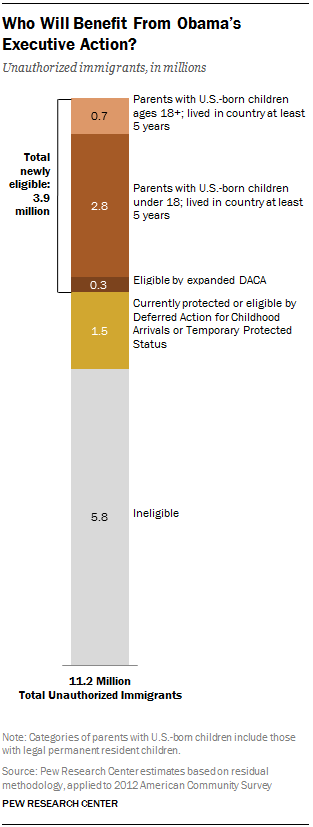
Unauthorized immigrants from Mexico account for two-thirds of those who will be eligible for deportation relief under President Obama’s executive action, even as they account for about half of the nation’s unauthorized population, according to a new Pew Research Center analysis.
The new action, which mainly applies to unauthorized immigrant parents of U.S. citizen or legal permanent resident children, would benefit those born in Mexico more than any other country of origin group. According to the Pew Research analysis, 44% of unauthorized immigrants from Mexico could apply for deportation protection under the new programs, compared with 24% of those from other parts of the world.
President Obama’s new programs could affect about 4 million total unauthorized immigrants who will be eligible for deportation protection and a three-year work permit. The largest group — at least 3.5 million, according to Pew Research estimates of 2012 data — consists of unauthorized immigrant parents who have lived in the U.S. for at least five years and have children who either were born in the U.S. or are legal permanent residents. Of these, about 700,000 have adult children and the remaining 2.8 million have children younger than 18.
The new policy also expands eligibility for the president’s Deferred Action for Childhood Arrivals (DACA) program that benefits young adults brought to the U.S. illegally as children. The program would allow an additional 330,000 people, according to our estimates, to apply for and receive temporary deportation relief. Previously, the program was available only to those up to age 30, but the executive action would lift that age cap. In addition, the program would allow immigrants who arrived as children illegally before Jan. 1, 2010 to become eligible, expanding the program beyond the original June 15, 2007 cutoff date.
In some cases, the Obama administration’s estimates of how many would be affected differ from those calculated by Pew Research. For example, the government estimates that more than 4 million parents of U.S. citizen children or legal permanent residents could apply for relief compared with our 3.5 million figure. One possible difference is that the data Pew Research uses only includes parents who live with their children.
While work permits and deportation relief will be available, those covered by the programs will not be eligible for certain government benefits, including subsidies for health care under the Affordable Care Act.
Among the other policy changes announced in the president’s action are an increased number of visas for skilled workers and spouses of green card holders. There are several changes, including immigration enforcement that will now focus on recent arrivals and serious and repeat criminal offenders.
Even though about 4 million unauthorized immigrants may be eligible for deportation relief, it remains to be seen how many people will apply for and receive it. Response to the existing DACA program may offer a clue. The 2012 program allowed an estimated 1.1 million people ages 30 or younger to become eligible for deportation relief and receive a two-year work permit. But through June 30, 2014, only about 712,000 applied.
The general public disapproves of Obama taking executive action on immigration, by a margin of 48% to 38%, according to a NBC News/Wall Street Journal survey conducted this month. While Americans may not generally support an executive action, the poll found 57% favor a pathway to citizenship for undocumented immigrants, with support increasing to 74% when respondents are given a scenario in which a pathway requires paying fines, back taxes and taking other steps.
According to a recent Pew Research Center survey, Hispanics place a priority on the relief from deportation offered by the executive action. By 56% to 35%, Hispanics said it is more important that unauthorized immigrants be able to live and work in the U.S. without threat of deportation than have a pathway to citizenship.
The estimated 4 million covered under the executive action are in addition to an estimated 1.5 million unauthorized immigrants who are eligible for temporary relief from deportation through either the Deferred Action for Childhood Arrivals program or having Temporary Protected Status.
The president’s executive action offers deportation relief for the largest number of unauthorized immigrants in recent history. However, the current action does not allow unauthorized immigrants the opportunity to obtain permanent residency or citizenship. Only Congress has the authority to offer a path to legal status, which means those eligible for relief under the new policy remain unauthorized. If a future administration reverses course or if Congress passes an immigration law, the protection from deportation could be taken away.
Correction: This posting has been updated with a revised total of 3.9 million unauthorized immigrants affected by the president’s action, and other related revised estimates. A previous version of this post referred to the president’s implementation of his new immigration policy as an executive order. He has taken executive action.

